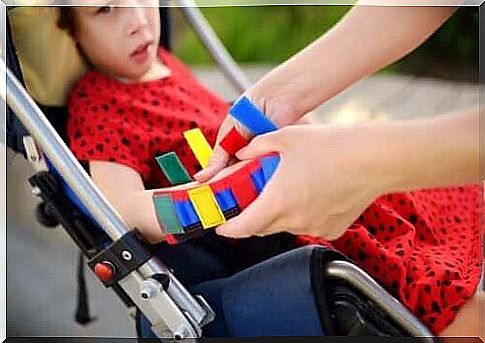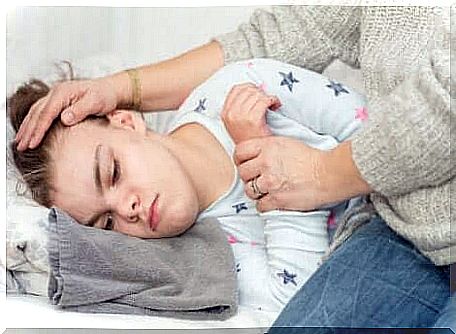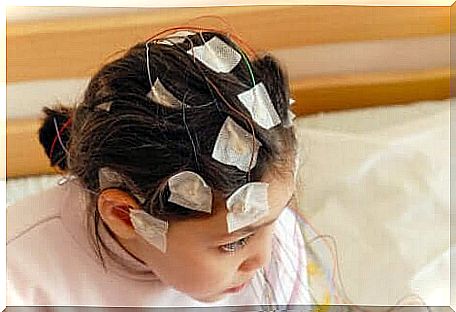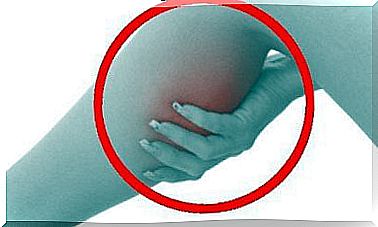Childhood Epilepsy: Causes And Detection
Childhood epilepsy is not a minor pathology. Its severity and condition, which tends to be chronic, make it a disease that seriously affects the quality of life of the child and his parents.

Conceiving childhood epilepsy as an alteration in the quality of life is difficult. In fact, the whole family of the affected child is involved in his care, in taking medication and in changing habits that could be harmful.
Epilepsy is a disorder of neuronal transmission, in which many nerve cells give off electric shocks at the same time. Depending on the location of the electrical activity, different types of epilepsy will result. In this article, we take a look at its causes and detection methods.
Prevalence and classification of childhood epilepsy
Data collected by the Child Neurology Foundation establishes that, of all children with diagnosed epilepsy, about 40% are free from seizures. This is important for the differentiation of diagnoses, as they are not the same.
For example, a child may have seizures without having epilepsy. If the symptom appears, additional methods necessary to find out the cause will be carried out. But the disorder may be due to another neurological or vascular pathology.
It is also known that around 20% of children with epilepsy also have an intellectual disability. This has an impact on the schooling of these children, who not only have to deal with their seizures, but who also see their education and their literacy being delayed.
However, not all childhood epilepsies are the same. According to the international classification, some start in the frontal part of the brain. And others in the side parts.
On the other hand, seizures can occur with or without seizures, with additional symptoms, with or without loss of consciousness. Likewise, in the context of convulsive seizures, the movements can be generalized or targeted on a limb, for example.

Causes and risk factors
Rather than establishing an origin for childhood epilepsies, it is better to understand that there are risk factors and causal situations. The intrinsic mechanism of neuronal discharge is not yet fully understood, but there is documentation about the contexts that favor this disorder.
The greatest risk arises in early childhood. Indeed, until the age of 4 years, febrile convulsions can be confused with epileptic episodes. The opinion of neurologists and pediatricians is crucial here.
On the other hand, genetics and family history are also important. When parents or grandparents have epilepsy, a child is more likely to develop the disease. Some genes have been labeled as triggers, but they still need to be stimulated by external factors that determine their expression. In other words, genetic inheritance will not always translate into symptoms.
Another cause of childhood epilepsy is brain infections and meningitis. This often manifests as a consequence and sequel of encephalitis, months or even years later.
Other risk factors for childhood epilepsy
On the other hand, head trauma can lead to seizure sequelae. It is a matter of prudence in the practice of a sport, especially during contact exercises such as football. For example, a child who has received a blow to the head may recover quickly, in full consciousness, and later be diagnosed with epilepsy.
Finally, vascular diseases represent another causal group. We are referring to alterations in cerebral circulation such as arteriovenous malformations, or cerebrovascular accidents.
These disorders are not as common in children as they are in adults. But it is important to know them in case of significant symptoms such as seizures or reduced mobility of the limbs.
A special aside is that of prenatal conditions. During pregnancy, toxins can pass from mother to fetus, affecting her neuronal development. Tobacco and alcohol are two substances that, when they cross the placenta, cause syndromes in the baby that can affect electrical transmission.
How is childhood epilepsy detected?
The suspicion of childhood epilepsy begins with the symptoms. Usually the first significant symptom is a seizure unrelated to fever in the child. From there, a series of complementary methods begin, guided by the pediatrician and the neurologist. Among these methods, the most important are:
Electroencephalogram
The electroencephalogram is a test that measures the electrical activity of the brain. Electrodes are then placed which, from outside the body, record the neuronal transmission. These data are then read by specialists to detect any abnormal discharges. It is not necessary to perform this test specifically during a seizure.

Brain tomography
Computed axial tomography of the brain can detect abnormalities in the structures of the skull that could cause seizures. A tumor, increased pressure in the cerebrospinal fluid, or an arteriovenous malformation.
Magnetic resonance
Like computed axial tomography, magnetic resonance is a complement for observing other softer structures.
Positron Emission Tomography (PET)
Recently, positron emission tomography has gained traction as a complementary method for various conditions, including childhood epilepsy. By injecting the patient with a metabolic substance, which is absorbed by the cells to be studied, it is possible to see this activity in the form of colors during a tomography or an MRI. This could make it possible to detect tumors or neuronal areas with high activity higher than normal, thus highlighting epileptic foci.
When in doubt, it is best to consult the pediatrician
Childhood epilepsy is not a disease that can be left unanswered. The faster the means of treatment and prevention are put in place, the better the quality of life of the child and his family. In many cases, suspicion is not easy, but if a seizure occurs, a professional assessment is essential.
Finally, the treatments are varied and have evolved over the years. Nowadays, we have more specific diagnostic tools with better sensitivity. As well as more accessible monitoring and rehabilitation protocols.









